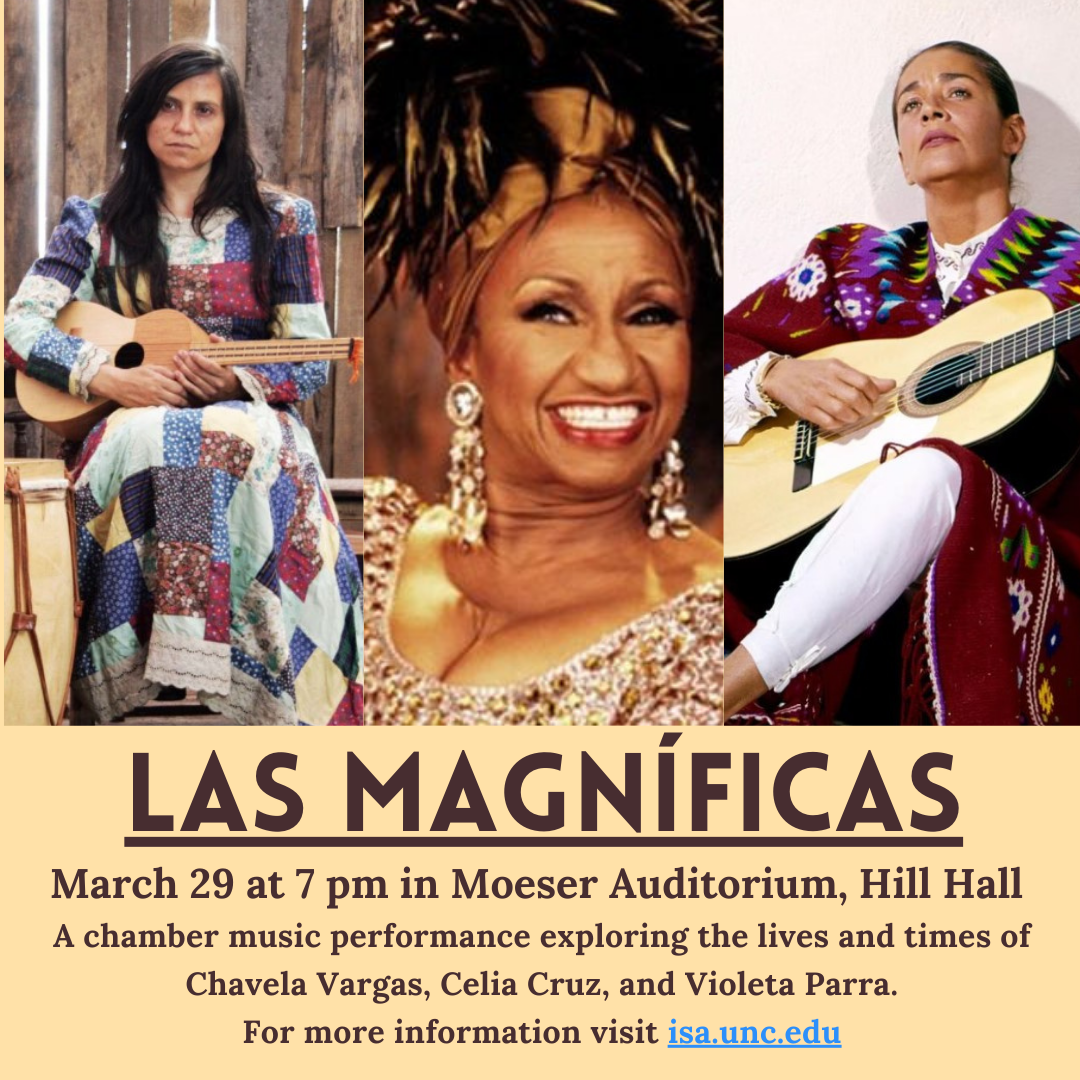Las Magníficas: Celia Cruz, Chavela Vargas, Violeta Parra
Speaker: CORE Ensemble
Date: March 29, 2023
Time: 7:00 PM
Address: Moeser Auditorium, Hill Hall
Las Magníficas is a Chamber Music Theatre piece performed by the CORE Ensemble. Las Magníficas focuses on the lives of three Latin American women: Chavela Vargas, Celia Cruz, and Violeta Parra. This is a free event and open to the public.
This event is a Campus Life Experience event.
Chavela Vargas
A prominent Mexican vocalist and actress from the Golden Age of Mexican cinema, Vargas began her singing career in the 1940s in Mexico City. Vargas was especially known for her powerful soulful renditions o Mexican ranchers, performed as a solo in a stripped-down fashion with only a guitar and performed with raw emotion. Instead of conforming to the dress and style of other female vocalists, Vargas took n a masculine persona, smoking cigars, drinking tequila, carrying guns, and performing in a poncho with her hair pulled back in a tight braid. She performed ranchers written for men expressing love towards women, accompanied only by an acoustic guitar instead of a full mariachi band, with the tempo slowed to dwell on heartbreak. Having made more than 80 recordings, Vargaas received a Latin Grammy from the Latin Academy of Recording Arts and Sciences in 2007. She continued to perform live for audiences until her death at the age of 93.
Celia Cruz
Cruz rose to fame in Cuba during the 1950s as a singer of guarachas, earning the nickname “La Guarachera de Cuba,” thereafter celebrated for decades as the “Queen of Salsa.” She began her career as a vocalist of the popular musical group La Sonora Matancera, an association that lasted fifteen years (1950- 1965), and early established a mastery over various genres of Cuban musical idioms, including guaracha, rumba, son, and bolero. Celia emigrated first to Mexico and later to the United States after the Cuban revolution. She soon established prominence as vocalist with the bands of Tito Puente, Johnny Pacheco, Ray Barreto, and Willie Colón, among others, recording a total of 37 studio albums. Among her many honors include two Grammy Awards and three Latin Grammy Awards.
Violeta Parra
Parra was a Chilean composer, folk singer, and social activist. One of the founders of the politically inflected Nueva Canción Chilena movement and musical genre. Her best-known song, “Gracias a
la vida” (1966), has endured as one of the most frequently performed and most often covered Latin American songs. The Nueva Canción Chilena served to synthesize Chilean folk traditions through which to direct attention to conditions among socially, economically, and politically marginalized peoples of Latin America and their struggle for social justice. During the 1960s, Parra turned her attention to “canciones que se pintan:” a series of paintings, sculptures, embroideries as a natural outgrowth of her music. Her arpilleras - huge embroideries - are the most complex of these works: ancestral images inspired by pre-Columbian art, telling stories full of timeless emotion. Parra’s arpilleras were a tool for relaying deeply felt needs that were private and shared, local and
international, and tied to both high and low culture. She committed suicide in 1967 at age 49 in Santiago.


